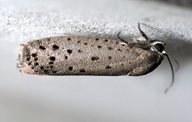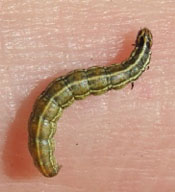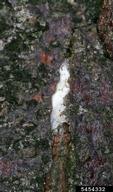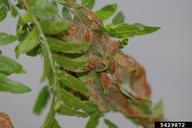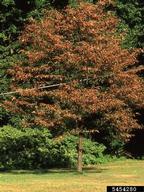Mimosa webworm
Homadaula anisocentra Meyrick (Lepidoptera: Galacticidae)
Orientation to pest
Mimosa webworm, Homadaula anisocentra Meyrick, is an invasive moth from China that was first recorded in North America in Washington, D.C., in 1940. Larvae feed on flowers and foliage of the introduced Asian silktree (mimosa) (Albizia julibrissin Durazz.) and the native North American honeylocust (Gleditsia triacanthos L.). Larvae web together areas on which they are feeding. This insect over-winters as pupae encased in cocoons on bark of their host tree or in the leaf litter below. Eggs of first generation moths are laid on leaves and hatch in early to mid-June. There are two generations each year and moths of the second generation moths emerge in August.
Hosts commonly attacked
The caterpillars of this moth feed on the introduced Asian silktree (A. julibrissin) and the native North American honeylocust (G. triacanthos).
Distribution
This insect occurs from Massachusetts and Pennsylvania, south to Florida and west to Mississippi, Kansas and Nebraska.
Images of mimosa webworm
| Figure 1. Adult of mimosa webworm, Homadaula anisocentra | Figure 2. Larva of mimosa webworm | Figure 3. A cocoon of mimosa webworm, the overwintering stage, in a bark crack |
| Figure 4. Web produced by larvae of the mimosa webworm | Figure 5. Host tree heavily damaged by mimosa webworm |
Important biological control agents related to this pest species
Some North American parasitoids attack this species, but parasitism rates are very low (2-4%). However, at least in Iowa one parasitoid, the eulophid Elasmus albizziae attacked 39-47% of the pupae.
Web links for information on mimosa webworm
Articles
- Heppner, J. B. and G. W. Dekle. 1975. Mimosa webworm, Homadaula anisocentra Meyrick (Lepidoptera: Plutellidae). Entomology Circular No. 157, Division of Plant Industry, Florida Department of Agriculture and Consumer Services.
- Bastian, R. A. and E. R. Hart, E. R. 1989. First-generation parasitism of the mimosa webworm (Lepidoptera: Plutellidae) by Elasmus albizziae (Hymenoptera: Eulophidae) in an urban forest. Environmental Entomology 19: 409-414.
- Sadof, C. S. and R. T. Snyder. 2005. Seasonal abundance of Homadaula anisocentra (Lepidoptera: Plutellidae) and two parasitoids, Elasmus albizziae (Hymenoptera: Elasmidae) and Parania geniculata (Hymenoptera: Ichneumonidae), in an urban forest. Environmental Entomology 34: 70-74.
